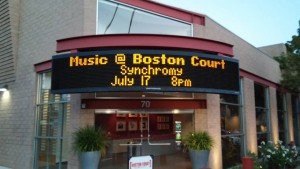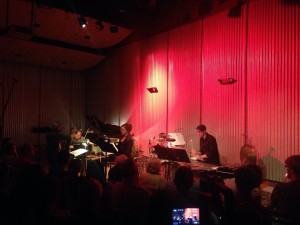Synchromy Concert in Pasadena
 Friday night July 17 and Boston Court in Pasadena was the venue for a concert titled Music From Text presented by Synchromy, the Los Angeles-based composers collective. Brightwork newmusic was the featured performing group and a sell-out crowd gathered for an evening of contemporary music based on the spoken word.
Friday night July 17 and Boston Court in Pasadena was the venue for a concert titled Music From Text presented by Synchromy, the Los Angeles-based composers collective. Brightwork newmusic was the featured performing group and a sell-out crowd gathered for an evening of contemporary music based on the spoken word.
Breathe by John Frantzen began the concert and this performance was the world premiere. Breathe is based on a poem written by composer’s brother about the trials, hardships and relationships as experienced in military life. In the program notes John Frantzen states that the music “strives to frame these words of support, honor and camaraderie in a journey of love, loss and enlightenment.” The piece began with a short section of the text spoken by a narrator followed by high-pitched bird calls and some bowing of the strings that suggested a lonely breeze in a far away place. The sound of a distant snare drum effectively evoked the military setting. The soprano voice of Justine Aronson was heard and the generally unsettled character of the passages in the strings hinted at the stress and confusion that is present in wartime. This was also portrayed by two actors on the stage whose movements intentionally suggested the strong bonds shared by soldiers in the field. At length the music gave way to a slow, dirge-like unison that was very beautiful. More dramatic action followed, ending in a sudden silence and the spoken word ‘breathe’. The viola and cello again took up the sorrowful theme and this was especially moving, even as the snare drum recalled the military context of what was fundamentally a story about relationships. Frantzen was able to draw a surprising amount of emotion out of the small musical forces in this piece. Breathe is a powerful work that captures both the anxiety and deep emotional attachments that are the essential elements of a soldiers life lived in harm’s way.
The next two pieces on the program were both based on text by Tao Lin and were played consecutively. The text of the first of these was taken from the poem I will learn to love a person and the music by Christopher Cerrone bore the somewhat expansive title I will learn to love a person and then I will teach you and then we will know. This began with spoken text followed by gentle tones in the vibraphone and clarinet. The entrance of Ms. Aronson’s lyrical soprano voice added to the delicate, airy texture and carried the melody forward by weaving in and around the vibraphone line. The dynamics here were carefully observed, adding an extra element of vividness to the realization. This piece agreeably reflects the calm character of the poetry and, as Christopher Cerrone states, “In writing these pieces, my hope is to create a work that reflects the strange and beautiful experience of growing up at the turn of the (21st) century – and will continue to have meaning after that moment passes.”
A declarative sentence whose message is that we must try harder by Jason Barabba followed the Cerrone piece without pause. This was played by a viola, cello and contrabass trio and started with a high pizzicato in the viola and some fast dissonant passages in the lower strings. There was tapping on the wooden parts of the instruments and this added to the feeling of a distant uncertainty as the anxiety mounted in a series of running phrases in the bass, viola and cello. Rapid running of the fingers up and down the strings produced a series of soft, unworldly screeches that added to the tension. This music is also based on the poetry of Tao Lin, but provided a fine contrast with the serenity of the previous piece. Jason Barabba writes that “Because this work is a reaction to a complex and provocative poem, I’ve chosen to take advantage of some of the more unusual techniques that have been introduced for these instruments.” These were deployed with good effect and the string players managed everything quite smoothly. The piece briefly turned warm and dark, but held to the tension of the preceding sections. The fast and turbulent finish was fittingly taut and mysterious. The playing of a declarative sentence whose message is that we must try harder was well matched to the writing of the music and these combined to persuasively express the composer’s intentions.
Hänschen Klein by Helmut Lachenmann followed and this was paired with Vera Ivanova’s The Laughing Man Alphabet, played sequentially without pause. The text of Lachenmann’s piece comes from a poem by Franz Wiedemann about a school boy – ‘little Hans’ – who moves away, returning seven years later having grownup and changed – and this became the basis of the first movement of a larger piano suite. The Laughing Man Alphabet is a series of variations on Lachermann’s original ‘little Hans’ theme, further exploring the story in the poem through a flute and piano duo. The flute playing by Sara Andon was superb, and included extended techniques such as vocalizing while intoning a passage – in this way the text was included, both in German and in English. The piano playing by Aron Kallay was of like quality, but more in a supporting role – the flute and piccolo were at the focal point of this piece. The Laughing Man Alphabet proceeded in various moods, sometimes as quiet and mystical with calm tones in the flute and soft strumming of the piano strings, sometimes mysteriously, as when whooshing sounds of air were heard, and sometimes with an active and powerful sound that gave off a sense of confusion and alienation. Vera Ivanova’s variations on Lachenmann’s original theme artfully extended the scope of the story and the virtuoso playing of Ms. Andon was received with enthusiastic applause.
After a short intermission the concert concluded with Settings from Pierrot Lunaire by William Kraft. This piece was commissioned by the Arnold Schoenberg Institute as part of the 75th anniversary commemoration of Schoenberg’s Pierrot Lunaire (1912). The same instrumentation was included: vocalist, flute, clarinet, piano, violin and cello and the text, by poet Albert Giraud, was sung in German. In the program notes William Kraft writes that “…the settings are an odd mix of a 12 tone row; double-mode hexachords formed into another row, an octatonic scale and the overtone mode (raised 4th and lowered 7th). All this will be exemplified in notes taken from various programs where the individual settings were premiered.” The intent of the Institute was to commission musical settings of the remaining 29 Pierrot cycle poems to compliment the 21 settings composed by Schoenberg in 1912. The conductor for this performance was Andreas Levisianos.
Settings from Pierrot Lunaire began with an instrumental Prelude that included a series of riffs in the piano and sustained tones in the strings. The strings and flute soon became agitated and a strong tutti entrance marked the beginning of the Feerie section; here the music turned angular and unsettled – nicely paralleling early 20th century sensibility. The singing of the textby Ms. Aronson and the ensemble playing was excellent, finding just the right balance between mystery and anxiety. An Interlude followed, featuring some bowed percussion that added a sense of mysticism, reinforced by strong phrases from the cello. A vibraphone entrance then formed a duo with the active cello riffs, and this was very effective. The percussion playing by Nicholas Terry in this section was exactly on target: precise and carefully nuanced.
Another sequence – Mein Bruder – followed, featuring more of the expressive singing of soprano Justine Aronson, whose voice seemed to hover weightlessly in the air. The instrumentation here added a palpable layer of tension to the text, especially Brian Walsh’s bass clarinet. Another short Interlude followed, made mysterious and unsettling by the excellent ensemble in the piano, flute, percussion and bass clarinet. Harlequinade was next and this had a more active and playful feel, as animated by the strings. The vocals were especially spirited, sometimes as recitative but more often with impressive acrobatics. Another interlude, Fantasmagoria, followed and this opened with a bell-like ringing and wild runs from the flute, clarinet and violin. The different lines chased each other around and around, adding to the sense of fantasy and movement. The percussion added a series of loud, rhythmic riffs and all the parts became more frenzied and agitated until the sound seemed to be coming in waves. Silence, broken only by a single ringing bell ended this section.
The final part of Settings from Pierrot Lunaire was the Selbstmord or Suicide section and for this the stage was bathed in a lurid blood red glow as the house lights dimmed. This section began with an expressively rendered spoken text followed by strong opening chords in the instruments. The soprano voice began softly, in an almost confidential whisper and roared upward in a gathering tension with the instruments following. Selbstmord proceeded in this way, alternating between quiet declamation and loud pyrotechnics in an altogether scary sequence. A slow decreshendo of instruments and voice seemed to die away in a fitting finish.
Settings from Pierrot Lunaire is, simply, a masterwork. William Kraft was in attendance and was acknowledged with enthusiastic applause and cheers by the audience at the conclusion of this expertly performed concert.
Brightwork newmusic is:
Aron Kallay, piano
Terry Stanislav, violin
Brian Walsh, clarinets
Sara Andon, flute
Nicholas Terry, percussion
Ashley Walters, guest cellist
Other musicians and actors in this concert were:
Alma Lisa Fernandez, Viola
Andreas Levisianos, conductor
Charlotte Gulezian, narrator
Justin Huen, narrator
Jessica Salans, director
Scott Worthington, contrabass
